#aomori contemporary art centre
Text
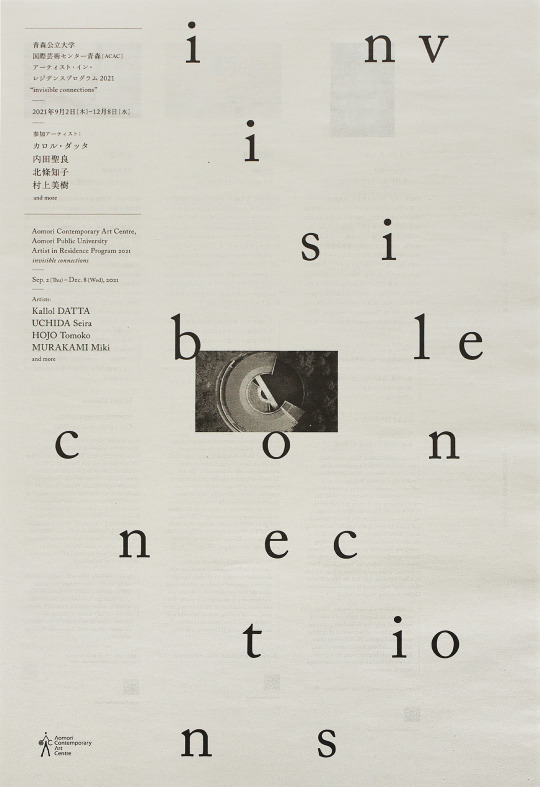
Hirotaka Honjo, Artist in Residence Program 2021 'invisible connections', Aomori Contemporary Art Centre (ACAC), 2021
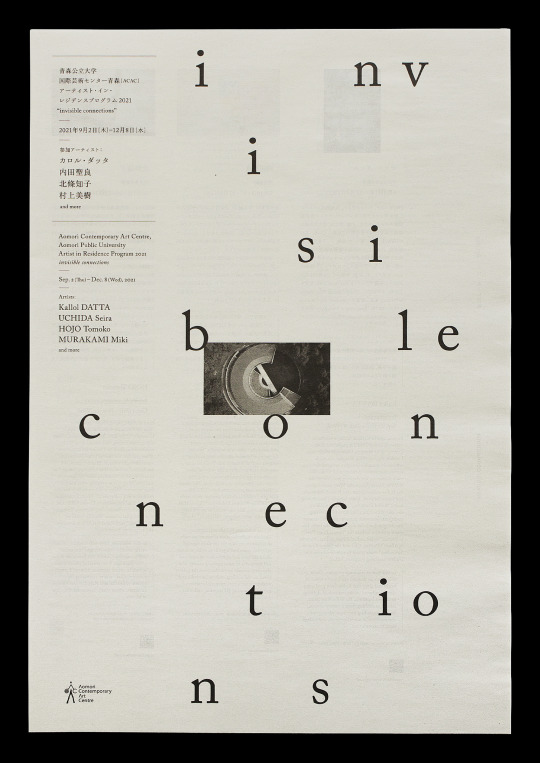

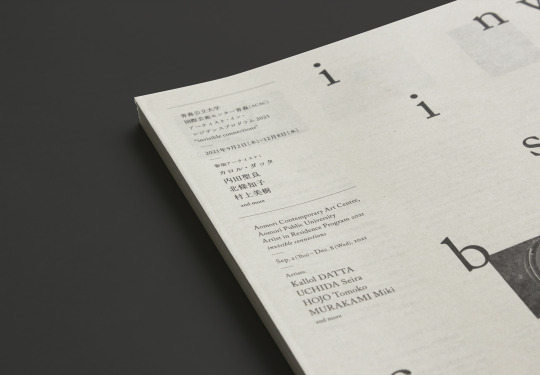
259 notes
·
View notes
Text
Artist Research - Nobuhiro Nakanishi (Layering)
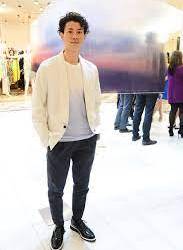
About - Nobuhiro is a Japanese artist, born in Fukuoka, Japan 1976. He studied sculpture at Tokyo Zokei University gaining Bachelor of Fine Arts, and Kyoto City of University of Art, of which he received an MA in 2002 when graduating. There is no more information on Nakanishi’s life, so I will mostly be talking about his work. He mostly works to create immersive installation experiences which attempt to capture the passage of time by using photography, sculpture and prolonged observation.
Nakanishi’s work typically involves presenting humans or objects in 3D interpretations using various media, such as wood, stone, clay and metal. He uses his art to express his thoughts around the antithetical ideas of existence and absence, the material and the non-material, the visible and the invisible, sense and conceptual territories such as consciousness, thoughts, memories and time, inviting the viewer into a mysterious and engaging experience.
Nakanishi’s installations render the abstracts and the ephemeral through serialised images on plexiglass panels, which he uses to portray the topics of absence, spatial-temporal perception and sensory experiences. Their work is typically produced as a series, by combining individual images together to produce an absract experience of the depicted subject, such as a sunset or the physical encounter with nature.
Nakanishi’s ‘Layered Drawings’ are created with photographs of environments that are taken over a long period of time and then chronologically arranged on acrylic panels to recreate temporal progressions, with small variations within each frame. This allows the art to be perceived where time has ‘no shape or boundary’, letting the experience differ from person to person. Within the gaps of the images, viewers can use their personal experience to add their perspective to the artists documentation, since each image has captured a different moment in the places history.
Nakanishi’s ‘Stripe Drawings’ depict landscapes in which distances and physical boundaries dissolve, such as a landscape covered in fog. For example; made from countless fine pencil lines produced at set intervals, the lines and spaces create shapes that appear to encroach on one another, yet coexist on the same plane - Stripe Drawing – Eclipse 3 (2013). Nakanishi implies that when the public track said lines, recreates the ‘physical experience’ of the artists free-hand drawing process, thus making the connection between the viewers and the artwork.
Nobuhiro Nakanishi has had a good amount of exhibitions, solo and group. Solo exhibitions include Gunma Museum of Art (2016); Yumiko Chiba Associates, Tokyo (2015); Kashya Hilderbrand, London (2014); Joyce Gallery, Beijing (2013); Aomori Contemporary Art Centre (2011); Gallery Nomart, Osaka (2010); and Osaka Contemporary Art Center (2006). Group exhibitions include Asia Culture Center, Gwangju (2015); Art Stage Singapore (2014); Toyota Municipal Museum of Art, Aichi (2012); The Museum of Modern Art, Wakayama (2011); 7th International Ink Painting Biennial, Shenzhen (2010); Hangaram Arts Center Museum, Seoul (2009); and Mori Art Museum, Tokyo (2007).

Quote - “We are all subject to the passing of time, yet each of us feels and perceives it in our own way,” Nakaniski says on his website. “Time itself has no shape or boundary and cannot be fixed or grasped. When we look at the photographs in these sculptures, we attempt to fill in the gaps between the individual images. We draw from our physical experiences to fill in missing time and space, both ephemeral and vague. In this series, I attempt to depict time and space as sensations shared by both viewer and artist.”
Thoughts - I’ve chosen to research Nobuhiro Nakanishi as I find his use of layer highly inspirational, I’d like to create something similar with my own work. I love the build up of colour, depth and dimension which are qualities rife within his art, creating visually intricate pieces that the viewer can dissect at each individual layer. I’d like to explore with his method of images on see through 2D material, to find how I too can create a scene that bring the viewer closer.
0 notes
Text
Artist Research - Nobuhiro Nakanishi

About - Nobuhiro is a Japanese artist, born in Fukuoka, Japan 1976. He studied sculpture at Tokyo Zokei University gaining Bachelor of Fine Arts, and Kyoto City of University of Art, of which he received an MA in 2002 when graduating. There is no more information on Nakanishi’s life, so I will mostly be talking about his work. He mostly works to create immersive installation experiences which attempt to capture the passage of time by using photography, sculpture and prolonged observation.
Nakanishi’s work typically involves presenting humans or objects in 3D interpretations using various media, such as wood, stone, clay and metal. He uses his art to express his thoughts around the antithetical ideas of existence and absence, the material and the non-material, the visible and the invisible, sense and conceptual territories such as consciousness, thoughts, memories and time, inviting the viewer into a mysterious and engaging experience.
Nakanishi’s installations render the abstracts and the ephemeral through serialised images on plexiglass panels, which he uses to portray the topics of absence, spatial-temporal perception and sensory experiences. Their work is typically produced as a series, by combining individual images together to produce an absract experience of the depicted subject, such as a sunset or the physical encounter with nature.
Nakanishi’s ‘Layered Drawings’ are created with photographs of environments that are taken over a long period of time and then chronologically arranged on acrylic panels to recreate temporal progressions, with small variations within each frame. This allows the art to be perceived where time has ‘no shape or boundary’, letting the experience differ from person to person. Within the gaps of the images, viewers can use their personal experience to add their perspective to the artists documentation, since each image has captured a different moment in the places history.
Nakanishi’s ‘Stripe Drawings’ depict landscapes in which distances and physical boundaries dissolve, such as a landscape covered in fog. For example; made from countless fine pencil lines produced at set intervals, the lines and spaces create shapes that appear to encroach on one another, yet coexist on the same plane - Stripe Drawing – Eclipse 3 (2013). Nakanishi implies that when the public track said lines, recreates the ‘physical experience’ of the artists free-hand drawing process, thus making the connection between the viewers and the artwork.
Nobuhiro Nakanishi has had a good amount of exhibitions, solo and group. Solo exhibitions include Gunma Museum of Art (2016); Yumiko Chiba Associates, Tokyo (2015); Kashya Hilderbrand, London (2014); Joyce Gallery, Beijing (2013); Aomori Contemporary Art Centre (2011); Gallery Nomart, Osaka (2010); and Osaka Contemporary Art Center (2006). Group exhibitions include Asia Culture Center, Gwangju (2015); Art Stage Singapore (2014); Toyota Municipal Museum of Art, Aichi (2012); The Museum of Modern Art, Wakayama (2011); 7th International Ink Painting Biennial, Shenzhen (2010); Hangaram Arts Center Museum, Seoul (2009); and Mori Art Museum, Tokyo (2007).
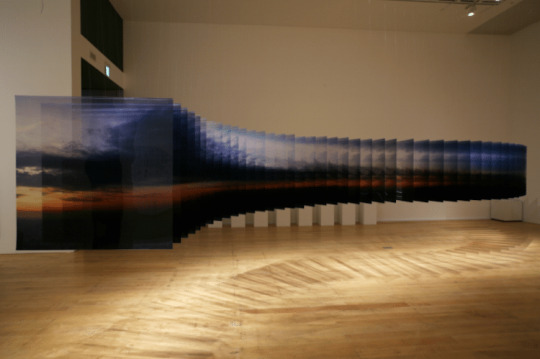
“We are all subject to the passing of time, yet each of us feels and perceives it in our own way,” Nakaniski says on his website. “Time itself has no shape or boundary and cannot be fixed or grasped. When we look at the photographs in these sculptures, we attempt to fill in the gaps between the individual images. We draw from our physical experiences to fill in missing time and space, both ephemeral and vague. In this series, I attempt to depict time and space as sensations shared by both viewer and artist.”
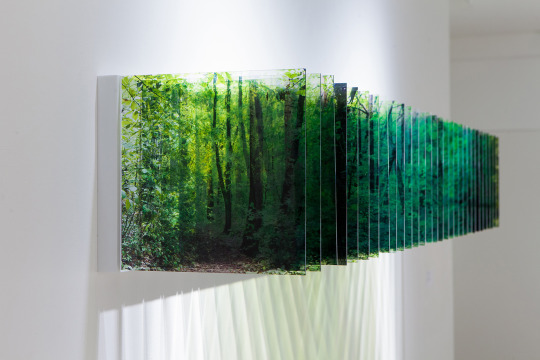
Thoughts - I’ve chosen to research Nobuhiro Nakanishi as I find his use of layer highly inspirational, I’d like to create something similar with my own work. I love the build up of colour, depth and dimension which are qualities rife within his art, creating visually intricate pieces that the viewer can dissect at each individual layer. I’d like to explore with his method of images on see through 2D material, to find how I too can create a scene that bring the viewer closer.
0 notes
Photo

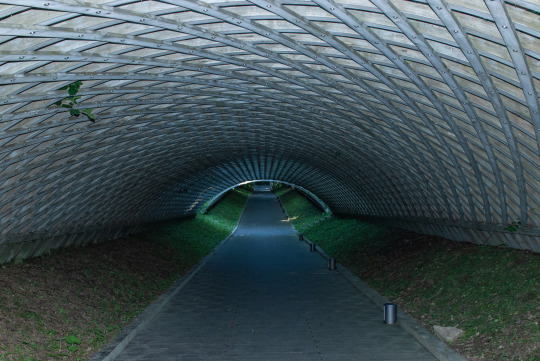


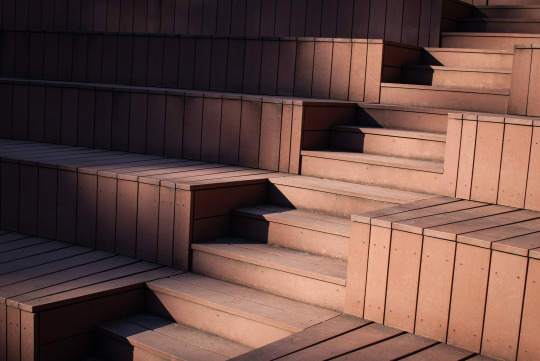
The Aomori Contemporary Art Centre(ACAC)
7 notes
·
View notes
Photo
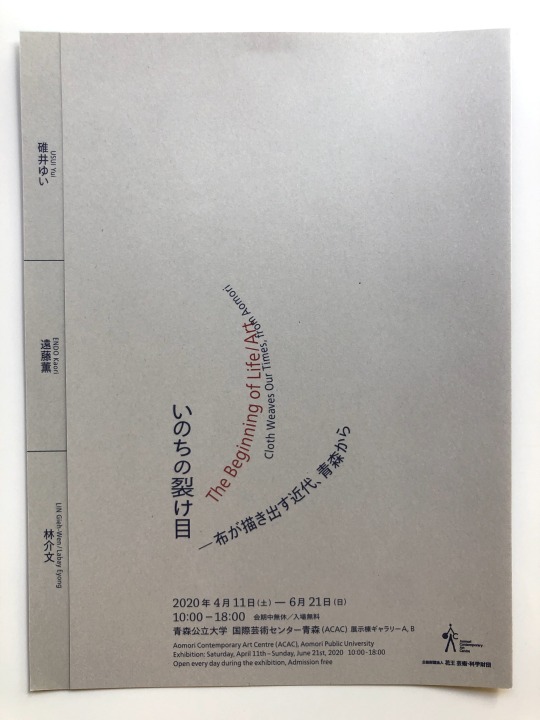
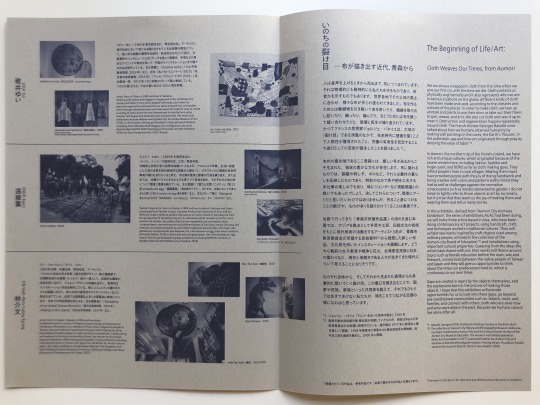


exhibition“The Beginning of Life/ Art -Cloth Weaves Our Times, from Aomori“@Aomori Contemporary Art Centre (ACAC), aomori, 2020
0 notes
Photo
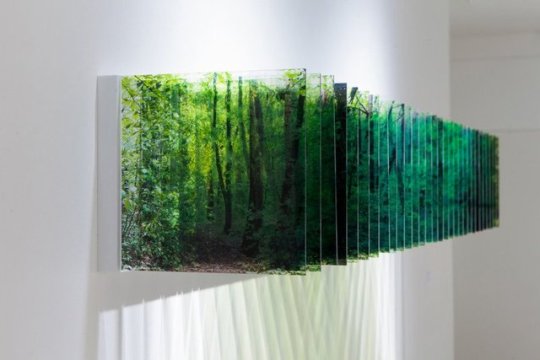
These Layers of Time Were Created by Arranging Photos on Acrylic http://ift.tt/2si2OxM
Japanese artist Nobuhiro Nakanishi has a project titled Layer Drawings that creatively uses photography to explore time, space, and 3D art installations. Each piece is a series of photos on a series of transparent acrylic sheets.
Transparent view, Aomori Contemporary Art Centre, Aomori, Japan (2011) © Nobuhiro Nakanishi, Courtesy of Yumiko Chiba Associates. Photo by Tadasu Yamamoto, courtesy Aomori Contemporary Art Centre, Aomori, Japan
For each piece, Nakanishi photographs one scene over a certain period of time. He then prints the photos on transparent film and mounts them to acrylic panels in chronological order, allowing the differences in the frames to be seen when looking through multiple layers.
RETICULATED TIME Kashya Hildebrand Gallery, London (2014). © Nobuhiro Nakanishi. Courtesy of Yumiko Chiba Associates. Photo by Susanne Hakuba
“We are all subject to the passing of time, yet each of us feels and perceives it in our own way,” writes Nakanishi on his website. “Time itself has no shape or boundary and cannot be fixed or grasped. When we look at the photographs in these sculptures, we attempt to fill in the gaps between the individual images. We draw from our physical experiences to fill in missing time and space, both ephemeral and vague. In this series, I attempt to depict time and space as sensations shared by both viewer and artist.”
Saturation, Osaka Contemporary Art Center, Japan
(2006). © Nobuhiro Nakanishi. Courtesy of Yumiko Chiba Associates. Photo by Seiji Toyonaga
You can find more of his work on his website and through Yukimo Chiba Associates.
(via Nobuhiro Nakanishi via Colossal)
Image credits: Header installation © Nobuhiro Nakanishi, courtesy of Yumiko Chiba Associates.
Photo by Susanne Hakuba
Go to Source
Author: <a href="http://ift.tt/2sXK2JQ Zhang</a>
If you’d like us to remove any content please send us a message here
CHECK OUT THE TOP SELLING CAMERAS!
The post These Layers of Time Were Created by Arranging Photos on Acrylic appeared first on CameraFreaks.
June 19, 2017 at 06:00PM
0 notes
Link
Artist: Yoshitomo Nara
Venue: Charles Moffett, New York
Exhibition Title: Yoshitomo Nara: An Exhibition of Works from a Private Collection
Date: February 29 – April 4, 2020
Click here to view slideshow
Full gallery of images, press release and link available after the jump.
Images:
Images courtesy of Charles Moffett, New York
Press Release:
Charles Moffett is pleased to present Yoshitomo Nara: An Exhibition of Works from a Private Collection. The show, which is comprised of two paintings, one sculpture and seventeen works on paper, have all been generously loaned to the gallery as part of a non-selling exhibition. On view from February 29 through April 4, 2020.
Yoshitomo Nara (b. 1959, Hirosaki, Aomori, Japan) grew up in Hirosaki, in Japan’s rural northern prefecture of Aomori. In 1987 Nara graduated with an MFA from the Aichi Prefectural University of Fine Arts and Music in Nagakute, Japan. Between 1988 and 1993 he studied at the Kunstakademie, Dusseldorf, Germany, subsequently spending a decade in Cologne. Beginning in the mid-1990s Nara’s work has been shown internationally in Europe, the United States, and Asia. In 2020, The Los Angeles County Museum of Art will open Yoshitomo Nara, the artist’s first international retrospective, which will travel to the Yuz Museum, Shanghai, the Museo Guggenheim Bilbao and the Kunsthal Rotterdam. He is currently represented by Blum & Poe and Pace.
Best known for his female figures, often depicted with oversized heads and mischievous expressions, Nara’s practice is rooted in a deep-seated fascination with history, politics, music and travel. This collection of drawings, paintings and sculpture meticulously draws on some the most iconic themes in Nara’s oeuvre. Consisting of 20 works, which range from 1999 to 2013, highlights include the 2012 acrylic on canvas painting In the Milky Lake, the 2013 bronze sculpture Miss Tannen and two works on paper created for inclusion in the artist’s children’s book, The Lonesome Puppy.
Solo exhibitions include Château La Coste, Le Puy-Sainte-Réparade, France (2019); For Better or Worse: Works 1987-2017, Toyota Municipal Museum of Art, Toyota, Japan (2017); Life is Only One: Yoshitomo Nara, Asia Society Hong Kong Center, Hong Kong, China (2015); Blum & Poe, Los Angeles, CA (2014); NARA Yoshitomo: a bit like you and me…, Yokohama Museum of Art, Yokohama, Japan, traveled to Aomori Museum of Art, Aomori, Japan and Contemporary Art Museum, Kumamoto, Japan (2012); The Crated Rooms in Iceland: Yoshitomo Nara + YNG, Reykjavik Art Museum, Reykjavik, Iceland (2009); Yoshitomo Nara + graf, BALTIC Centre for Contemporary Art, Gateshead, UK (2008); Yoshitomo Nara + graf, Museum of Contemporary Art, Den Haag, Netherlands (2007); From the Depth of My Drawer, Hara Museum of Contemporary Art, Tokyo, Japan, traveling exhibition (2004); Nothing Ever Happens, Museum of Contemporary Art, Cleveland, OH, traveling exhibition (2003); and I Don’t Mind, If You Forget Me, Yokohama Museum of Art, Yokohama, Japan, traveling exhibition (2001).
Link: Yoshitomo Nara at Charles Moffett
from Contemporary Art Daily https://bit.ly/2VUj5rK
0 notes
Photo
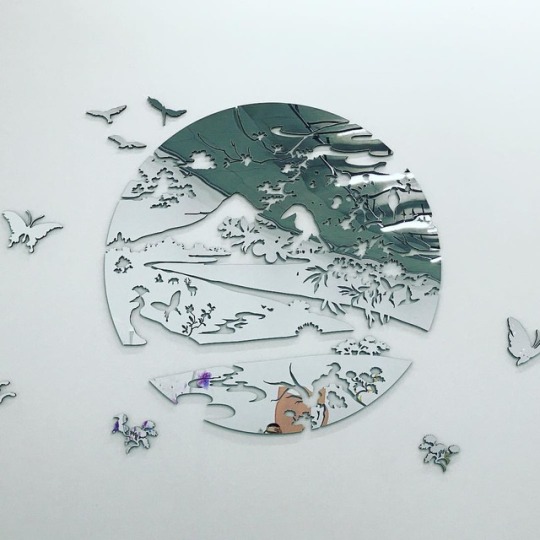
Can I hang this on my wall please? Part of a lovely little exhibition called 'Paradise/Boundry, where we were once' by Misa Funai at the Aomori Contemporary Art Centre. (at 国際芸術センター青森)
0 notes
Photo

These Layers of Time Were Created by Arranging Photos on Acrylic
Japanese artist Nobuhiro Nakanishi has a project titled Layer Drawings that creatively uses photography to explore time, space, and 3D art installations. Each piece is a series of photos on a series of transparent acrylic sheets. Transparent view, Aomori Contemporary Art Centre, Aomori,...
More at FactPatrol: https://factpatrol.com/2017/06/20/these-layers-of-time-were-created-by-arranging-photos-on-acrylic/
#Photography
0 notes
Text
Japan's House of 33 Years was once two separate buildings in two different towns
The past and the future coexist in this daylit house in Nara, Japan. Tokyo-based architecture studio ASSISTANT designed the house as a cluster of small buildings for an elderly couple who places great value on preserving memories. The result is a steel-framed structure that was built in several different locations and then assembled on-site to create several overlapping spaces.
Local carpenters in Aomori built the main quarters of the house using locally available materials. The project was initially installed as part of the “Kime to Kehai” exhibition at the Aomori Contemporary Art Centre. After the exhibition, the team disassembled the structure and loaded it on a truck to transport it to Nara, where it was reassembled as the House of 33 Years.
Related: Renovated Vietnamese home ‘sewn’ together with intricate steel threads
Students at the Sendai School of Design built the rooftop pavilion as an homage to Philip Johnson’s Ghost House. Before becoming a permanent part of the house, the pavilion was installed in the courtyard of a university campus and used by the students as a space for growing vegetables.
+ ASSISTANT
Via Archdaily
Lead photo by Shinkenchiku-sha
from DIYS http://ift.tt/2qiQcpC
0 notes
Text
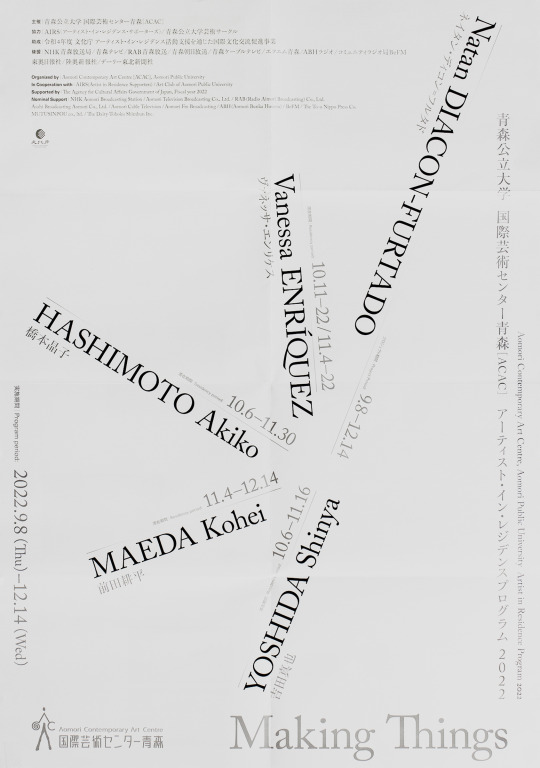
Hirotaka Honjo, Artist in Residence Program 2022 'Making Things', Aomori Contemporary Art Centre (ACAC), 2022
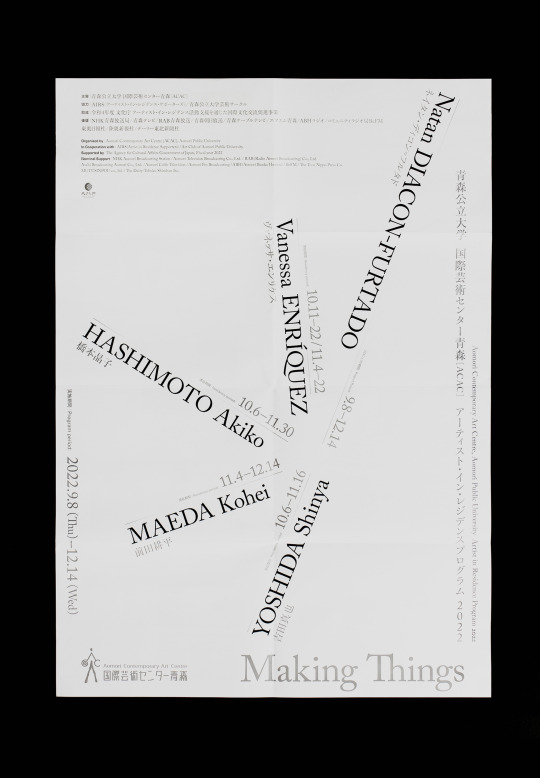
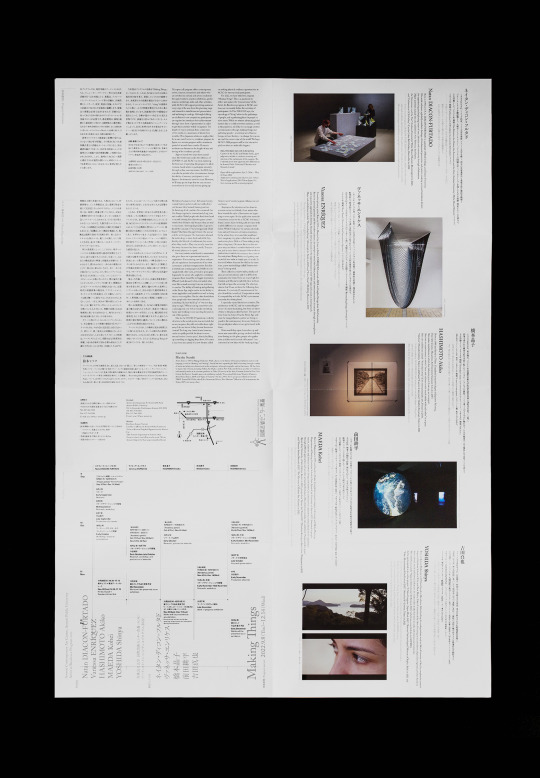

81 notes
·
View notes
Text
Japan's House of 33 Years was once two separate buildings in two different towns
The past and the future coexist in this daylit house in Nara, Japan. Tokyo-based architecture studio ASSISTANT designed the house as a cluster of small buildings for an elderly couple who places great value on preserving memories. The result is a steel-framed structure that was built in several different locations and then assembled on-site to create several overlapping spaces.
Local carpenters in Aomori built the main quarters of the house using locally available materials. The project was initially installed as part of the “Kime to Kehai” exhibition at the Aomori Contemporary Art Centre. After the exhibition, the team disassembled the structure and loaded it on a truck to transport it to Nara, where it was reassembled as the House of 33 Years.
Related: Renovated Vietnamese home ‘sewn’ together with intricate steel threads
Students at the Sendai School of Design built the rooftop pavilion as an homage to Philip Johnson’s Ghost House. Before becoming a permanent part of the house, the pavilion was installed in the courtyard of a university campus and used by the students as a space for growing vegetables.
+ ASSISTANT
Via Archdaily
Lead photo by Shinkenchiku-sha
from DIYS http://ift.tt/2qiQcpC
0 notes
Text
Japan's House of 33 Years was once two separate buildings in two different towns
The past and the future coexist in this daylit house in Nara, Japan. Tokyo-based architecture studio ASSISTANT designed the house as a cluster of small buildings for an elderly couple who places great value on preserving memories. The result is a steel-framed structure that was built in several different locations and then assembled on-site to create several overlapping spaces.
Local carpenters in Aomori built the main quarters of the house using locally available materials. The project was initially installed as part of the “Kime to Kehai” exhibition at the Aomori Contemporary Art Centre. After the exhibition, the team disassembled the structure and loaded it on a truck to transport it to Nara, where it was reassembled as the House of 33 Years.
Related: Renovated Vietnamese home ‘sewn’ together with intricate steel threads
Students at the Sendai School of Design built the rooftop pavilion as an homage to Philip Johnson’s Ghost House. Before becoming a permanent part of the house, the pavilion was installed in the courtyard of a university campus and used by the students as a space for growing vegetables.
+ ASSISTANT
Via Archdaily
Lead photo by Shinkenchiku-sha
from DIYS http://ift.tt/2qiQcpC
0 notes
Text
Hyperallergic: Art Movements
Three-dimensional rendering of the Statue of Idrimi (C16th BC) (via Sketchfab)
Art Movements is a weekly collection of news, developments, and stirrings in the art world.
Karan Vafadari and Afarin Nayssari, the founders of Aun Gallery, were charged with “attempting to overthrow the Islamic Republic of Iran” by Judge Abolqasem Salavati. The couple have been held in prison without recourse to legal counsel for over eight months.
A group of artists and art workers protested the opening of Carl Andre: Sculpture as Place, 1958–2010 at the Los Angeles Museum of Contemporary Art. Among other actions, the group handed out thousands of postcards with an image of artist Ana Mendieta and the phrase “Dónde está Ana Mendieta? (Where is Ana Mendieta?).” Andre was acquitted of all charges related to Mendieta’s death in 1988.
The British Museum collaborated with the Factum Foundation to produce precise 3D renderings of the 3,500-year-old statue of Idrimi — the Syrian refugee who later became King of Alalakh in southern Turkey. The work of the Foundation, the non-profit wing of Factum Arte, was profiled by New Yorker contributor Daniel Zalewski last year.
Over 150 members of Congress signed a letter advocating for increased funding for the National Endowment of the Arts. Eleven House Republicans are among the signatories.
Casino magnate Frank Fertitta settled his claims against art historian Oliver Wick. Fertitta paid the art historian $150,000 after he allegedly described a Mark Rothko painting that Fertitta later purchased as “perfectly fine.” The work was subsequently revealed to be one of over 30 fakes sold by the now defunct Knoedler Gallery.
(via Facebook/Rds Rds)
A man stepped on a blue pigment work by Yves Klein during a press conference for an exhibition dedicated to the artist at the Musée d’art moderne et d’art contemporain in Nice, France.
Marc Chagall’s “A Wheatfield on a Summer’s Afternoon” (1942) was removed from the foyer of the Philadelphia Museum of Art, where it was displayed for over three decades. The monumental work will be loaned to the Aomori Museum of Art in Japan where it will be temporarily reunited with the three other theatre backdrops that the artist designed for the 1942 production of Aleko by Léonide Massine for the Ballet Theatre of New York.
A collection of unpublished letters written by Sylvia Plath includes allegations of domestic abuse according to a report by the Guardian. The letters, which Plath sent to Dr. Ruth Barnhouse, came to light after an antiquarian bookseller put them up for sale for $875,000. A statement issued from the Ted Hughes estate on behalf of the poet’s widow, Carol Hughes, described the claims as “absurd.”
Pawel Machcewicz was dismissed from his role as director of the newly-opened Second World War Museum in Gdansk. Poland’s right-wing government intends to merge the museum with the still-unbuilt Westerplatte Museum in order to create a new state sanctioned institution.
Artists Against Evictions, an Athens-based artist group, published an open-letter addressed to the participants and visitors of Documenta 14 decrying the government’s eviction of artists and round-up of refugees and displaced persons around the city.
Norfolk Museum Service launched a crowdfunding campaign to cover part of the cost of putting a monumental Napoleonic-era ensign back on display. The ensign, which measures 16 meters by 8.3 meters (~52.5 feet by 27 feet), was captured from the French warship Le Généreux by Captain Sir Edward Berry in February 1800.
Plans to establish a museum dedicated to Hilma af Klint (1862–1944) were placed on hold due to a dispute between the project’s organizers and the artist’s descendants.
Installation view, Hilma af Klint: Painting the Unseen at Serpentine Gallery, London, March 3–May 15, 2016) (image © Jerry Hardman-Jones)
Gillian Wearing was commissioned to create a statue of suffragist Millicent Fawcett. The artist will become the first ever woman to create a statue for Parliament Square in London.
The site of the Bell Foundry arts space was put up for sale with a listing price of $1 million. The property was condemned by the City of Baltimore last December leading to the evictions of dozens of local artists.
Arturo Di Modica, the creator of Wall Street’s “Charging Bull,” claimed that Kristen Visbal’s “Fearless Girl” violates his artistic and commercial rights.
Numerous alarmed residents mistook smoke billowing from the Fridericianum Museum in Kassel as a fire. The white smoke is part of an installation entitled “Expiration Movement” by artist Daniel Knorr.
The National Gallery of Denmark launched a new initiative to assist individuals who wish to improve their Danish language skills.
London-born DJ, Dax J, was handed a one-year prison sentence in Tunisia for remixing the Muslim call to prayer during a performance.
Artist Ardian Syaf was fired by Marvel for including religious references in a recent X-Men comic.
The Kentucky Coal Mining Museum converted to solar power.
Transactions
Tracey Emin with “Death Mask” (2002) at the National Portrait Gallery’s conservation studio (© Tracey Emin/National Portrait Gallery, London, photo © Jorge Herrera)
The National Portrait Gallery in London acquired Tracey Emin’s “Death Mask” (2002).
The New York Public Library’s Schomburg Center for Research in Black Culture acquired the personal archive of James Baldwin.
Robert Ryman donated 21 of his works to the Dia Art Foundation’s permanent collection.
Real estate entrepreneur Chris Bratty donated almost 25,000 photographs of Canadian news events to the Ryerson Image Centre. The images are drawn from the New York Times photo archive.
Eataly, Mario Batali’s chain of Italian grocery stores, backed the financing of an “advanced air filtration system” to help extend the life of Leonardo da Vinci’s “The Last Supper” (1495–98).
Transitions
Arts journalist Randy Kennedy left the New York Times to join Hauser & Wirth as director of special projects. Kennedy had worked at the Times for 23 years. As outlined in the gallery’s press release, Kennedy will “helm a number of new editorial, writing, and documentary initiatives for web and print, including relaunching and expanding the gallery’s magazine Volume, for which he will serve as Editor-in-Chief.”
Bruce W. Dunlevie was appointed to the J. Paul Getty Trust’s board of trustees.
Eran Neuman abruptly stepped down as the new director of the Israel Museum in Jerusalem.
Susan Sayre Batto was appointed executive director of San Jose Museum of Art.
Milton Curry was appointed dean of the University of Southern California’s School of Architecture.
William Kentridge founded the “Centre for the Less Good Idea” in Johannesburg, an arts space “for uncertainty, doubt, stupidity and, at times, failure.”
Jeffrey Deitch plans to open a new gallery space in Los Angeles.
Carriage Trade Gallery will reopen at new location on the Lower East Side this month.
Pierre Huber announced the closure of the Art & Public gallery in Geneva.
Architect Peter Zumthor unveiled a revised design for the Los Angeles County Museum of Art‘s $600 million expansion.
The Museum of Contemporary Art, Chicago raised its general admission fee from $12 to $15, while extending free admission to anyone aged 18 or under. The fee changes will go into effect on June 1.
Central Park’s Belvedere Castle will be close at the end of the summer for restoration work.
Belvedere Castle, Central Park, New York (via Flickr/Stig Nygaard)
Accolades
Carolee Schneemann was awarded the Golden Lion for Lifetime Achievement at the Venice Biennale.
The John Simon Guggenheim Memorial Foundation announced the recipients of its 2017 Fellowships.
The Leonore Annenberg Fellowship Fund announced its final grant recipients.
Hilton Als was awarded the Pulitzer Prize for Criticism.
The Anderson Ranch Arts Center will award its 2017 National Artist Award to Wangechi Mutu on July 20. Other honorees include Ronnie and Jan Greenberg (Service to the Arts Award) and Ann Korologos (Extraordinary Service Award).
Peter Walker was awarded the inaugural Richard Brettell Award in the Arts.
The National Portrait Gallery in Australia awarded Gary Grealy the 2017 National Photographic Portrait Prize for his portrait of Richard Morecroft and Alison Mackay.
Graphic designer Ian Macfarlane won first prize in Dezeen’s unofficial Brexit passport design competition.
Ian Macfarlane’s unofficial Brexit passport design (via Dezeen)
Obituaries
Kishori Amonkar (1932–2017), singer. Renowned performer of classical Hindustani music.
Lonnie Brooks (1933–2017), blues singer and guitarist.
Louis Frémaux (1921–2017), conductor
J. Geils (1946–2017), guitarist.
Linda Hopkins (1924–2017), singer and actress.
Joanne Kyger (1934–2017), Beat Generation poet.
Patricia McKissack (1944–2017), author.
Christopher Morahan (1929–2017), director and producer.
Charlie Murphy (1959–2017), comedian. Brother of Eddie Murphy.
Glenn O’Brien (1947–2017), writer and art critic. Member of Warhol’s Factory and first editor of Interview magazine.
Paul O’Neill (1956–2017), founder of the Trans-Siberian Orchestra.
Lorraine Pearce (1934–2017), first White House curator.
David Peel (1942–2017), singer.
Don Rickles (1926–2017), comedian.
Carlo Riva (1922–2017), engineer and yacht designer.
Louis Sarno (19542017), ancestral music archivist.
The post Art Movements appeared first on Hyperallergic.
from Hyperallergic http://ift.tt/2p2QvFr
via IFTTT
0 notes
Link
Artist: Yuki Okumura
Venue: Keio University Art Space, Keio University Art Center Archive, Tokyo
Exhibition Title: The Man Who, An Ephemeral Archive
Date: November 9 – November 22, 2019
Curated By: Hitoshi Kubo and Yohko Watanabe
Note: Two versions of the exhibition leaflet can be downloaded here and here.
Click here to view slideshow
Full gallery of images, press release, and link available after the jump.
Images:
Video:
Yuki Okumura, The Man Who, 2019. HD Video, 116 minutes 15 seconds (Japanese subtitled version)
Installation images courtesy of Keio University Art Center, Tokyo. Photos by Calo works Co. Ltd. Film stills courtesy of the artist and MISAKO & ROSEN, Tokyo. Scanned photographs by Jean-Hubert Martin, 1993.
Press Release:
When stating that somebody is an interesting person, or a boring person, one is actually reducing various behaviors of that person into a flat image and entrenching her or him in this thin plate. However, of course, that person’s behaviors are not always interesting or boring, but just different each time. Above all, the defined character one applies to the person depends purely on one’s perspective and standpoint.
This solo exhibition by Yuki Okumura revolves around his latest film entitled The Man Who (2019), which comprises nine people’s recollections about somebody they call “him.” It is Okumura’s attempt to untangle the rigidly fixed bundle to which diverse aspects of “him” have been put together, multilayering the image through a series of procedures reminiscent of overlaying different photographic plates one after another. Here, “he” indeed emerges as a singular man every time the pronoun is pronounced, but also turns into plural men as the nine interviewees deliver their stories. This duality tears apart the man/men toward two poles, namely their most general states and their most specific states, between which we encounter countless versions of “the man who” — each is simultaneously “him” who looks very much like anybody and a similitude of “him” who looks absolutely like nobody.
This exhibition also includes an act of placement of a collection of three reference items related to the film into the archive of Keio University Art Center, lasting just for the show’s duration.* Along with The Man Who, which is at once an artistic film work and an oral historical referential material, this intervention is to provoke fresh discussions as to what a material really is for an archive and what kind of possibilities archival materials can open up today. Indeed, as shown by the nine individuals narrating their memories with “him” in the film, each of us has a body that is an archive on its own, established in this physical world and accessible only for a fleeting moment.
* Open to any researcher but a preliminary online reservation is necessary. Please make a reservation here.
Special viewing on Saturday, November 9
13:00 Screening: The Man Who (2019 | HD video | 116 minutes 15 seconds) *
15:30 Discussion: “The Process of Doubles” (Yuki Okumura x Yusuke Minami x Yohko Watanabe x Hitoshi Kubo) **
* Not on view during the discussion. Screened continuously on other exhibition days.
** Japanese only.
Yuki Okumura
A man who was born in Aomori, 1978, and now lives in Brussels and Maastricht. Artist. In many of his projects, Okumura inserts his own life and fantasy in a specific area of recent art history, reactivating it in the present timeframe as a site of uncertainty that develops through ever-changing interpersonal relations, driven by his belief in the essential parallelity of worlds and the ultimate interconnectedness between individuals. Recent solo exhibitions include Hisachika Takahashi by Yuki Okumura (2016 Maison Hermè Le Forum, Tokyo. Curated by Reiko Setsuda), Na(me/am) (2018, Convent, Ghent. Organized by Jeroen Staes and Wouter De Vleeschouwer) and 29,771 days – 2,094,943 steps (2019, LA MAISON DE RENDEZ-VOUS, Brussels. Presented by MISAKO & ROSEN).
Hitoshi Kubo
A man who was born in Tokyo, 1977 and now lives in Kanagawa. Archivist, among other activities. Departing from certain archives or specific referential materials and montaging various spatiotemporal perspectives that they encompass, many of his projects shed light on not only events that occurred but also those that could have occurred, fundamentally as a way for him to explore possibilities to redesign conditions of human experiences as variable circuits by means of observation, analysis, and construction of montages employed in films and other artistic works, driven by his trust to the world, which in his eyes essentially stands as a process of self-generation and flickering. Recent writings include Montaging Penumbra: on a Motif of Archive (report for JSPS Grants-in-Aid for Scientific Research 26580029 | 2017) and “A Case of a Studio: Shuzo Takiguchi and a Laboratory,” NACT Review, no. 5 (2018 | National Art Center Tokyo). At Keio University Art Center, he has directed a project to reconsider archives, called Pleating Machine (2018–).
Yusuke Minami
A man who was born in Tottori, 1959 and now lives in Yokohama and Nagoya. Curator. Director of Aichi Prefectural Museum of Art since April 2017, after working at Tokyo Metropolitan Art Museum, the Museum of Contemporary Art Tokyo (MOT), and the National Art Center, Tokyo (NACT). His curated exhibitions are mainly related to contemporary art and 20th century art. The former ones include solo exhibitions of Natsuyuki Nakanishi (1997), On Kawara (1998), Takashi Murakami (2001) and Tadanori Yokoo (2002) at MOT as well as Kazumi Nakamura (2014) and Yayoi Kusama (2017) at NACT, along with group exhibitions such as “MOT Annual 1999: Modest Radicalism” (1999) at MOT and “Artist File 2008” (2008), “The Light: MATSUMOTO Yoko / NOGUCHI Rika” (2009) and “Given Forms: TATSUNO Toeko / SHIBATA Toshio” (2012) at NACT. The latter ones include group shows such as “Living in the Material World: “Things” in Art of the 20th Century and Beyond” (2007), “Le Surrealisme: Exposition organisee par le Centre Pompidou a partir de sa Collection” (2011) and “American Pop Art From the John and Kimiko Powers Collection” (2013), as well as large-scale retrospectives of Picasso (2008), Man Ray (2010), Magritte (2010) and Dalí (2016), all at NACT.
Yohko Watanabe
Born in 1961. Professor, Keio University Art Center. Curator. As the Vice Director of Keio Museum Commons, she is engaged with establishing a new vision of a university art museum. All of her organized exhibitions are characterized by a consistent curatorial attitude despite their smallness in scale and marked by her belief that working in tandem with an artist’s work in the real sense means looking at each piece sincerely and meeting the artist and encountering the profound depth of the artistic realm through such commitment. Her curated shows at Keio University Art Space includes the 2012–2015 series entitled “Contemporary Eyes” (iteration I being “Hamish Fulton: Five Walks,” II “from here: stanley brouwn and Daniel Buren,” III “Sunrise and Sunset: Bruce McLean, 1985 – 90,” IV “The Light Dwells: Imi Knoebel” and V “Blinky Palermo”) and a new series since 2017 called “Standing Point” (iteration I being “Yoko Terauchi and II “Ana Mendieta”).
Link: Yuki Okumura at Keio University Art Space, Keio University Art Center Archive
Contemporary Art Daily is produced by Contemporary Art Group, a not-for-profit organization. We rely on our audience to help fund the publication of exhibitions that show up in this RSS feed. Please consider supporting us by making a donation today.
from Contemporary Art Daily http://bit.ly/2PArmMP
0 notes
Link
Takuro Tamayama
Artists: Takuro Tamayama, Tiger Tateishi
Venue: Nonaka-Hill, Los Angeles
Exhibition Title: Takuro Tamayama and Tiger Tateishi
Date: July 27 – August 31, 2019
Click here to view slideshow
Takuro Tamayama, Eclipse, 2019, digital video, 19:00 loop
Full gallery of images, videos, press release and link available after the jump.
Images:
Videos:
Takuro Tamayama, Dance, 2019, digital video, 1:00 loop
Takuro Tamayama, Eclipse, 2019, digital video, 19:00 loop
Images courtesy of Nonaka-Hill, Los Angeles
Press Release:
Nonaka-Hill is pleased to present a two-artist exhibition, Takuro Tamayama and Tiger Tateishi. The show features a new installation, video and sculpture works by Takuro Tamayama, brought together with Tiger Tateishi’s large oil painting Rotating Fuji from 1991 and selected prints dating from 1973-1981.
Takuro Tamayama and Tiger Tateishi, while generations apart, share penchants for surprising fantasy narrative works depicting evolutions of our planet and others, often through the anthropomorphism of common objects. While both artists engage a repertory of domestic symbols, always colorful and often spinning, Tamayama’s work appears distinctively spare and Tateishi’s work is distinctively baroque.
At the gallery entrance, Takuro Tamayama’s new monochrome yellow video Dance plays on a monitor, bathed in blue light from the underside of a semi-circular table. On the tabletop, a sculpture of a sandwich linked to a hamburger stands upright on a plate, looking “human”. The one-minute video shows a choreography of six rotating gold rocks, swirling into a configuration resembling one body as we know it (head/torso/ two arms/ two legs), then repositioning in three pairs, suggesting three even-more rudimentary bodies (head/body), all nodding, before all exit stage left/right. Adjacent, Tiger Tateishi’s Planets Blossom silkscreen presents a narrative image sequence of round planets cracking, transforming into rose planets. A red curtain leads to Tamayama’s colored light-saturated room scale immersive experience entitled Eclipse Dance (2019). A cluster of tables forms a new Pangea-like plateau, dividing the atmosphere’s light into intense red above and hazy blue below. A rotating veined white marble form, again evocative of a human, is positioned with tense relationship to a spherical form, evocative of a celestial body – perhaps a sun, or a moon. In the next space, Tamayama’s Eclipse, a new large-scale video projection with sound composed by the artist, presents well-known objects of domesticity (especially cleaning), cast into a weightless and elastic, unknown space. This atmosphere is also a narrative which shifts to reveal the silhouette of Tamayama’s rudimentary figure slowly eclipsing a hazy planet, all set to a repeating, trance-inducing stanza. A fourth space, saturated with blue light, presents Tamayama’s spinning red monochrome sculpture of a hanging, double-headed mop whose fiber string head has fully transitioned into long red, human hair. This rotating work confronts Tateishi’s comic-strip format painting Rotating Fuji (1991), which is lit precariously by white light imposed into the blue atmosphere. The painting depicts six views of Mt. Fuji tumbling outside the window of room, occupied by scampering furniture, all set within grids of floral wallpaper and marble. A fifth room, painted yellow, displays Tateishi’s prints dating from 1973 to 1981. Each of these works show a fantasy of planet formation, evolution and/or anthropomorphic transformation.
Takuro Tamayama: Attracted to the narratives which common objects can create in relationship with each other, Tamayama began staging objects and sculpture in room scaled installations as early as 2012. These immersive environments offer no linear means to comprehend Tamayama’s narrative, rather the environment is the decentralized narrative of symbols. Often, tools of the mundane rituals of cleaning and grooming abandoned of its designated role anthropomorphize into alien objects. In absence of human presence, the mop, an abstracted marble figure, hybrid hamburger and sandwich statue, and combs imbedded in irregular concrete forms, all having some human resonance, occupy the human void. In his recent works, Tamayama has utilized curtains to reorganize the space experience, and colored lights to saturate and destabilize the visual senses. He produces long-form video and music, adding to the time and non-materiel dynamics of these constructed spaces. Tamayama’s new video installation, Eclipse is inspired by Tateishi’s fascination with aliens, UFOs and outer space, as both artists construct alternate dimensions of illusions and fantasy.
Takuro Tamayama was born in 1990, Gifu Prefecture, Japan. He lives and works in Tokyo. Tamayama was awarded first place in Aichi University of the Arts, 2012 Class Bachelors of Fine Art Graduate Project, 2013. Tamayama received a Masters Degree in Fine Arts from the Tokyo University of the Arts in 2015. He is the recipient of Art Award Tokyo Marunouchi 2015 Shigeo Goto Award. Tamayama’s developing oeuvre includes installations, video, music, wall-based and sculptural works, as well as collaborative installation projects for Nike and the fashion brand, Zucca. He has had numerous solo and group exhibitions in Japan including recent solo shows, Dirty Palace at Calm & Punk Gallery, 2018 and They Hardly Ever Stand Still at Talion Gallery, 2019, both in Tokyo. This is Tamayama’s first exhibition outside of Japan.
Tiger Tateishi: Enchanted by Disney cartoons and American movies in his youth, Tiger Tateishi was later drawn to Mad Magazine and stories by science fiction authors, Ray Bradbury, Arthur C. Clarke, and Robert Sheckley. He began his art career in 1963, producing “Pop Art” paintings from a Japanese point of view, colliding Japan’s iconic Mt. Fuji, Godzilla, and Samurai together with international icons such as Mao Tse Tung, an atomic mushroom cloud, MAD Magazine’s Alfred E. Neuman, Coca-Cola, the American Western landscape and KKK processions. To parody the tourism initiatives of the 1964 Tokyo Olympic Games, Tateishi founded The Institute of Tourist Art (1964-66), creating works which operated off the Mt. Fuji as beloved national symbol and tourism moneymaker. His first solo exhibition of the same year was titled Accumulated Civilization, an idea which echoes through his oeuvre.
With the desire to draw “nonsense cartoons”, then unpopular in Japan, Tateishi and his wife Fumiko left for Milan in 1969, drawn to the city of Futurism. Notably, their move was concurrent with other new frontiers felt globally; Stanley Kubrick’s 2001: A Space Odyssey (1968) and the Apollo 11 first moon landing. As a consummate absorber of his surroundings, Tateishi met Giorgio de Chirico (whose perspectival style he had appropriated earlier in 1964) and merged de Chirico-style images into a new storyboard sequencing in his paintings. This format, usually only seen in comics, proved ideal for making paintings of Sci-Fi narratives. An employee of Ettore Sottsass’s saw these works and introduced the architect/designer to Tateishi and an extraordinary group of drawings were produced setting Sottsass’s early proposals for fantastical and erotic architectural forms in outer space terrains. While attributed to Sottsass, these works are often signed “Tiger pinxit”, Latin for “Tiger painted it”. Tateishi also started making silkscreen prints from the early 1970s in Milan, a selection of which are on view. These works, and Rotating Fuji incorporate the story-board format which Tateishi continued to utilize in paintings, drawings and artist’s books throughout his career.
Tiger (Kōichi) Tateishi was born in 1941, Fukuoka Prefecture, Japan. He passed away in 1998. He received a degree from Musashino University Junior College of Art and Design in 1963. Tateishi’s vast oeuvre includes oil painting, prints, comics, illustration, children’s books, and ceramics. Since 1963, the artist has had numerous solo and group exhibitions in Japan, Europe, and the United States. After his death, two retrospectives were organized: Tiger Tateishi: The Endless Tiger at Tagawa City Art Museum, 1999 and Metamorphose Tiger: Walking through the Labyrinth with Tiger Tateishi, O Museum,1999 (cat.). Tateishi was featured in a two-artist shows, The World is Strange! The Manga and painting of Tiger Tateishi and Yuichi Yokoyama, Hiroshima City Museum of Contemporary Art, 2017. Recent group exhibitions include Tokyo 1955-1970: A New Avant Garde, 2012; The Museum of Modern Art, New York, Japanorama: A New Vision on Art Since 1970,Centre Pompidou-Metz, 2018. A touring Tateishi survey exhibition is planned for 2020/2021 appearing at Chiba City Museum of Art, Aomori Museum of Art, Takamatasu Art Museum and The Museum of Modern Art, Saitama.
Link: Takuro Tamayama, Tiger Tateishi at Nonaka-Hill
Contemporary Art Daily is produced by Contemporary Art Group, a not-for-profit organization. We rely on our audience to help fund the publication of exhibitions that show up in this RSS feed. Please consider supporting us by making a donation today.
from Contemporary Art Daily http://bit.ly/2A2K6gU
0 notes